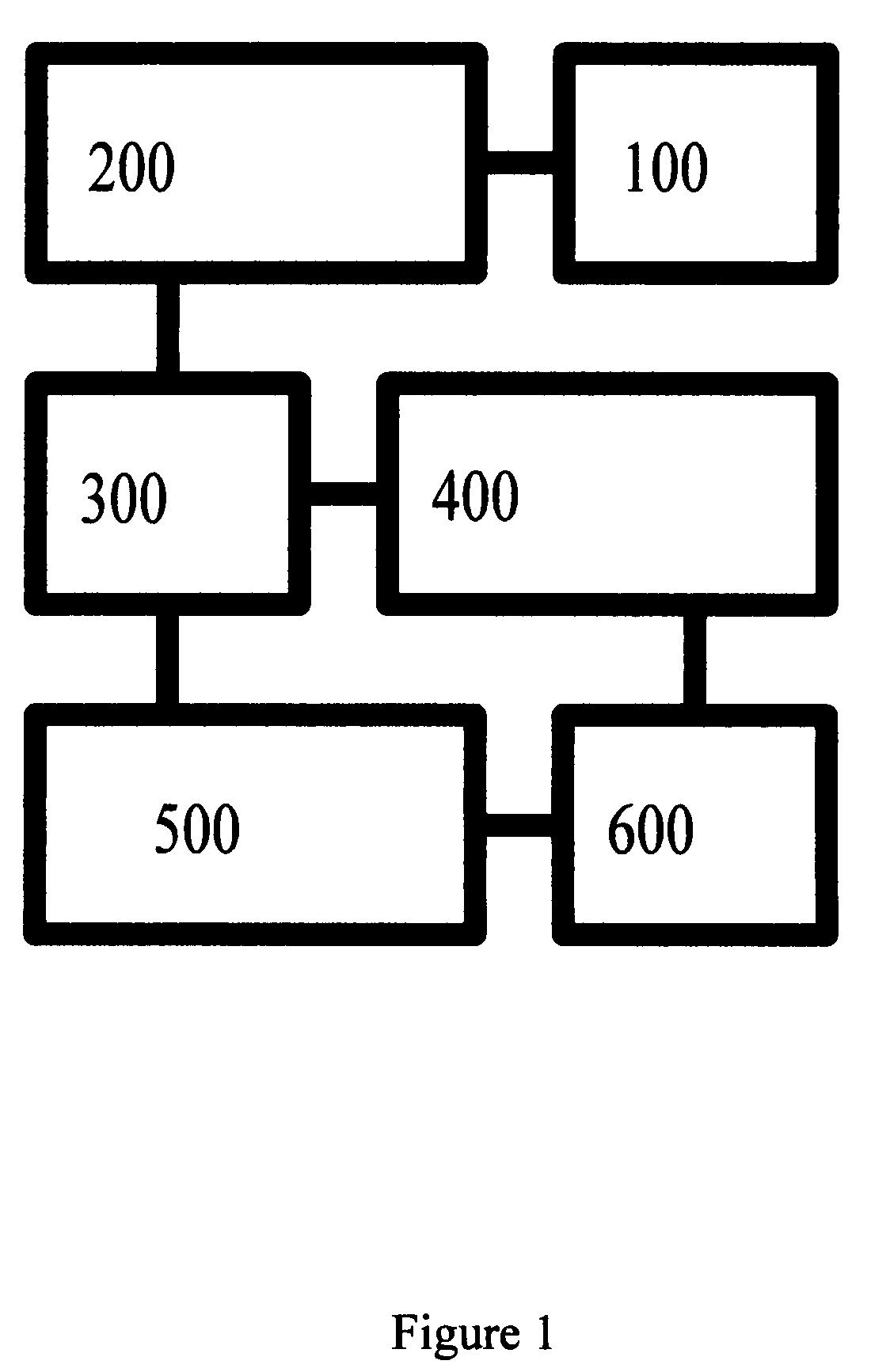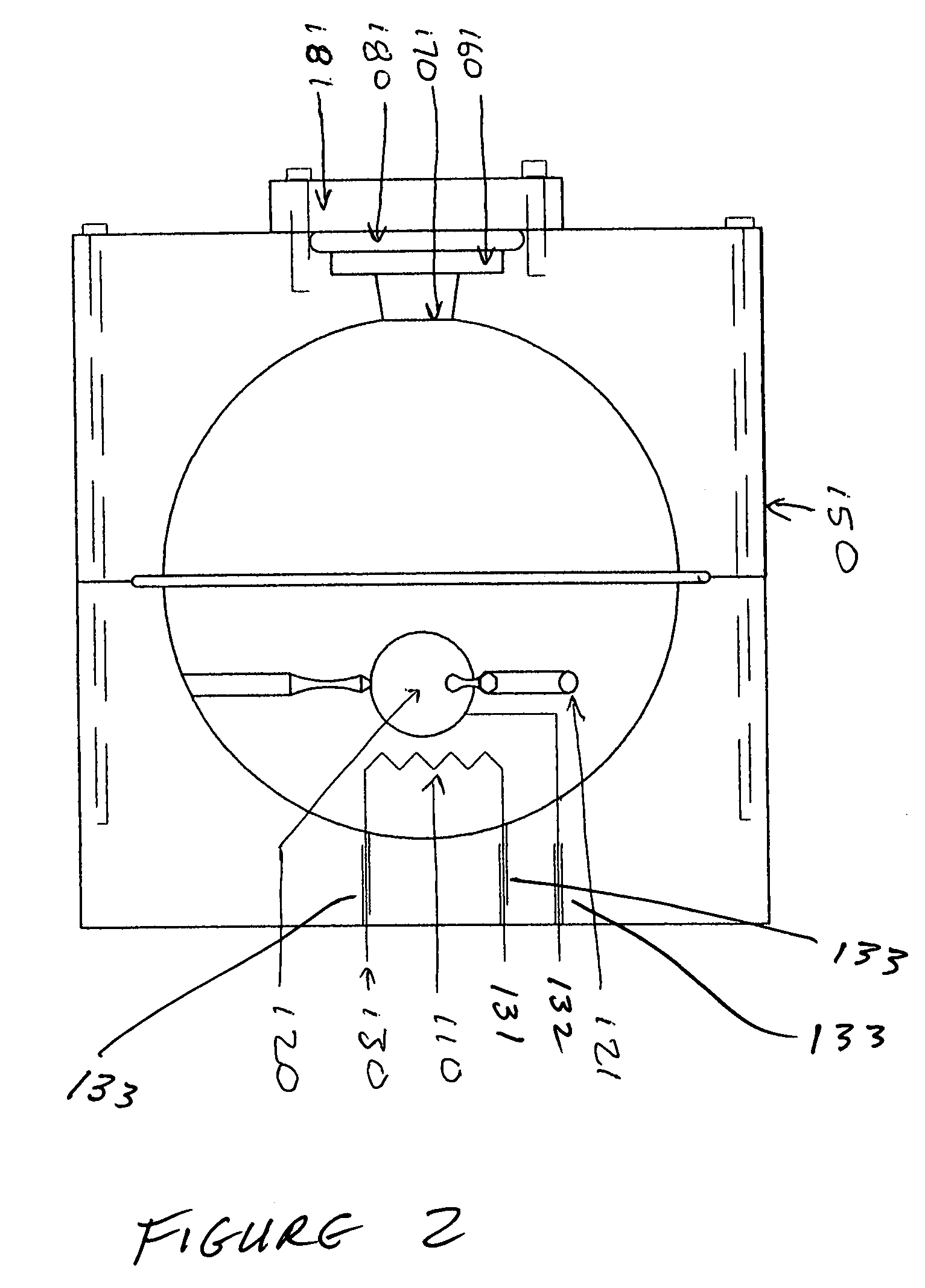The Joint Services-Lightweight Standoff
Chemical Agent Detector (JS-LSCAD) has very good instrinsic selectivity, but only moderate sensitivity because of the limited
throughput.
However, they are quite large (15 to 25 cm lengths) relative to handheld footprints, have very low power efficiency (0.01%), excessive
power consumption and
waste heat (˜15 watts),
shock sensitivity and limited operating lifespan (2,000 to 10,000 hours).
Unfortunately, their frequency stability generally is inadequate for FT-IR measurements, being about 3 orders of magnitude worse than the HeNe type.
First, the higher differential
solubility of organic vapors in some materials, relative to air, concentrates or captures vapors from a large volume of air passed over a material, typically a
polymer.
For a blackbody radiator at practical temperatures (˜1500K), the output power emission peaks in the visible
wavelength range where it is not useful.
The mercury-
cadmium-
telluride (MCT) detectors employed in conventional
infrared measurements cost roughly US$1000 to $2000 each and require the use of a relatively expensive long-path gas
cell, as well as the aforementioned problem of detecting a small
signal in the presence of a large background.
High-sensitivity
nickel-membrane microphones (e.g., Model 4176, Bruel & Kjaer Products, Nærum, Denmark) are themselves quite expensive, being about the same US$1000 cost as MCT detectors.
While the volume production of PAS microphones probably can not achieve the full economy of scale of
consumer devices, the technology is still very cost-effective compared to conventional high-sensitivity microphones.
Further, it is too costly for widespread deployment.
To date, no FT-IR instruments have yet been manufactured in a handheld
footprint.
Radiation losses include
infrared radiation that propagates away from the source in undesirable directions, and
radiation of unusable wavelengths that propagates in the desired directions.
Absent further improvements such as the
vacuum chamber and reflectors, their efficiency cannot be as high as the preferred approach described below.
If a
slide projector is used without such a filter, it can quickly melt (or combust) slides.
Further, drilling holes in it for the support rods is quite difficult.
However, if the
voltage is too high, emission of soft x-rays can result.
The preferred source body is aluminum, which is highly conductive and a poor coefficent match to glass.
However, glass provides a poor coefficient match to aluminum.
A
gallium arsenide window material is not an ideal coefficient match either to the aluminum source chamber or
indium seals.
The critical tradeoff between interferometer size and
signal-to-
noise performance is that the
throughput is proportional to the aperture area.
Because volume can be quite limited in a handheld instrument,
throughput is a critical issue.
A complementary view is that the throughput limitation of interferometers arises from a mismatch of curvature between the wavefronts coming from the two arms.
The mismatch leads to a variation of
optical path difference across the
field of view, which causes blurring and loss of contrast in the interference fringes.
The field widening of Doyle's design usually is modest, because most versions, if not all, employ
potassium bromide (KBr) scanning wedges and scan only the wedge.
The limits of stabilization performance have not been measured fully, in part because this step can require a stabilized
Helium-
Neon laser (e.g., 05 STP 901, Melles Griot, Carlsbad, Calif.) which is fairly expensive.
One
disadvantage relative to solenoids is that any heat generated by the coil must be carried by the air in the
magnet gap, unless other cooling provisions are made.
Two significant
power consumption issues are driving air through the preconcentration resin and heating the resin to desorb compounds.
For portable instruments, it can be inconvenient to provide a supply of
inert gas, so air can be used.
The upper
temperature limit for
Tenax™ TA resin operating in air is 200 C. Operation at higher temperatures can result in decreasing effectivness because of permanent resin degradation.
The
cooling effect can be boosted by the use of Peltier cooling devices, but they are rather inefficient and power consuming.
Heating of the
polymer material needs to proceed very rapidly, which is difficult for a material that has a large surface area (and consequently high
porosity).
Grate had observed that some preconcentration tubes spontaneously fail[xxiii] and it was thought that overtemperature might be responsible for damage to the resin.
The vane life can then be the life-limiting component.
While thermoelectric (TE) cooling can be used with an MCT
detector to avoid the cost, weight and vibrations of a
cryocooler, the D* performance can suffer.
Cryocoolers can readily reach 77K, but until recently had been quite expensive and provided only limited lifetimes. TE coolers can only reach 230K, but are less expensive and more compact.
Unfortunately, TE devices are quite inefficient.
The use of PA detection can rival the sensitivity of MCT
detector with an expensive multipass gas
cell.
However, heating is undesirable as it tends to reduce the photoacoustic
signal intensity.
However, sensitivity is reduced more if the analytes condense on the walls, because the high
thermal conductivity can greatly reduce the signals.
This is comparable to the cost of an MCT
detector.
These conventional microphones are quite expensive, being in the range of $800 to $1500 each for a 12.7-mm
diameter.
However, it is only
noise in the spectral bandwidth of the sample that affects the SNR of a particular measurement.
The necessary calculations can be managed readily by a desktop PC, but can be a strain for handheld computers at the present time.
Several of the blocks contained in the diagram are digital filters, which can require very significant processor power.
One final issue of concern for processors is the physical size.
Microcontrollers are small microprocessors with limited capabilities, intended for
embedded applications.
These protocols could be implemented in
software, but dedicated modules operate independently from the core processor and therefore only require limited
programming and
processing for operation.
A multiply-accumulate operation takes only one
instruction cycle, but unfortunately the input and output of the multiply engine points only to specific registers.
However the manufacturer's data sheet specifies that it can consume 146 mA at 5 V when operating at 30 million
instructions per second.
However, the devices with larger gate counts are only available in ball-grid array (BGA) packaging.
It is unlikely that the photoacoustic data can require this high a resolution.
Although the
distributed logic of the FPGA allows for increased speed of the processor, it also complicates power consumption estimates.
Digital transistors consume power only when switching, and therefore the power consumption is highly dependent upon the
clock frequency and the number of active transistors.
Since the number of transistors being used is determined by the program running, actual power consumption can only be determined when the
programming is complete.
In addition, this device is only available in a ball-grid
package, which can make prototype
assembly difficult.
This allows for a smaller
battery pack, when compared to using an additional 12 batteries to create a bipolar supply, but at the expense of additional power supply switching noise.
Elaborate
overcharge protection is required because overcharging can result in
metallic lithium being plated out on the
anode, with the potential for explosion and fire.
Even charging too fast can cause explosion and fire.
These materials can be injection molded, but do not have the favorable thermal properties of aluminum.
Aluminum is susceptible to mechanical damage—bending—if dropped, providing another reason to cover the instrument with a layer of foam insulation.
However, cast aluminum cannot be
diamond turned because of the
oxide inclusions.
Red, yellow and green LEDs can indicate dangerous levels of organic vapors, questionable levels and safe levels, respectively.
The most computationally demanding tasks are data collection and
processing.
However, the
power budget for the
electronics is a very modest 5 watts, much less than the typical 100 watts for a desktop CPU.
Such an instrument is likely to be too small for a functional keyboard.
 Login to View More
Login to View More  Login to View More
Login to View More 


